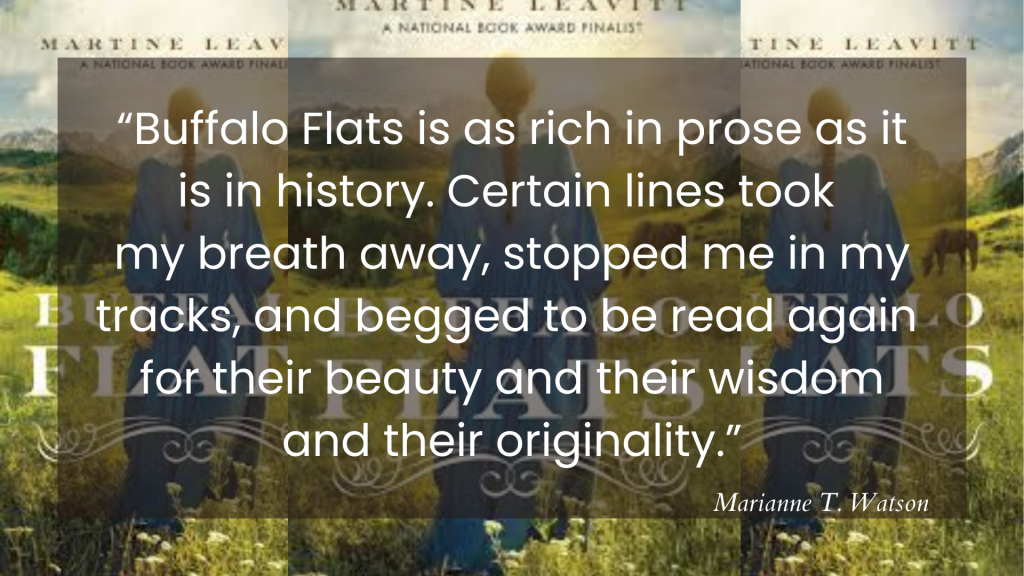Articles/Essays – Volume 58, No. 1
Invigorating the Latter-day Saint Pioneer Woman Narrative | Martine Leavitt, Buffalo Flats
“Rebecca had heard her father and others call this land God’s country often enough that she wasn’t as surprised as she might have been to come upon him, one warm spring evening, sitting on the tor overlooking Buffalo Flats. He was dressed in his work clothes, but you knew God when you saw him.”
These are the opening lines to Buffalo Flats, Martine Leavitt’s latest addition to young adult literature. From the first paragraph, two irrevocably important pieces of our protagonist’s heart are handed to us: her relationship with God and her love of the land. The entire novel works like this, with frank, piercing honesty from eighteen-year-old Rebecca Leavitt, who wants nothing more than to own her own parcel of land and enjoy God’s country as a homesteader for the rest of her life. The trouble? Rebecca is a woman, and in 1890s Northwest Territories (Rebecca’s section of the territories is known today as Alberta, Canada), a woman is “not [a person] in matters of rights and privileges” and cannot own land. A further obstacle is the $480 price, not to mention her family’s meager finances. Undeterred, Rebecca seeks a way around the law and, throughout the narrative, doggedly pursues her dream of homesteading. Combine this with Rebecca’s mother, who publicly speaks against domestic abuse, and Rebecca’s sister-in-law, who actively works as a suffragette, and you’ll find a cast of strong female characters, all of whom fulfill traditional feminine roles (wife, daughter, mother) while also seeking equality and safety for women and girls. This novel is a tribute to the women activists of the era.
Though the opening chapters read quite slowly as characters, relationships, and Latter-day Saint pioneer customs are established, the narrative quickly picks up the pace as romantic tensions are introduced, Rebecca’s chances of securing her land are compromised, and as bears, disease, floods, abuse, prejudices, death, and famine threaten her life and her loved ones. Make your way through the first fifty pages as you would a mountain meadow, enjoying the flowers and the birdsong, and you’ll soon be met with a river of a story that quickly rides into a steep waterfall. The view at the end of the book is breathtaking. It’s worth the journey. I promise.
Martine Leavitt’s previous work is well decorated. Her 2006 novel Keturah and Lord Death was a finalist for the National Book Award, 2013’s My Book of Life by Angel was a finalist for the Los Angeles Times Book Prize and winner of the Canadian Library Association Young Adult Book Award, and 2016’s Calvin won the Governor General’s Literary Award. Leavitt’s previous works, including these award-winners, pertain to contemporary, magical realism, and fantasy genres. With Buffalo Flats, Leavitt also demonstrates her mastery of historical fiction. Throughout the novel, Leavitt interweaves historical artifacts (such as a handsewn patchwork quilt and traditional courting candles, used during visits between sweethearts) with historic social practices (such as Sunday church and box lunch socials) and historic events (such as the “grippe” influenza and the North Western Coal and Navigation Company irrigation project) without skipping a beat on plot and characters. The world-building is seamless, convincing, and delightful.

Buffalo Flats is as rich in prose as it is in history. Certain lines took my breath away, stopped me in my tracks, and begged to be read again for their beauty and their wisdom and their originality. A few examples:
- “Rebecca had come to her parents a daughter after six sons. . . . The way Ammon told it, when Rebecca came along, she was an afterthought, a shrug, after the straight-shouldered pride of all that male offspring, a concession to God that they must take the bad with the good. But their beloved mother bent over that bit of flesh as if it were her own heart lying in the cradle, and the boys had to go along with it.”
- “Then his mouth was on hers, and right then and there, she and Coby invented kissing . . . her spine bloomed into flame, until all that was left was light on bone.”
- “At some point, Rebecca became too sick to care if she cried. Her chest burned, her head was filled with a pain as if little horns had been torn from her skull and caustic rubbed into the holes. She was a small animal in the jaws of a wolf: shaken, limp, crushed. She opened her eyes once and looked at her fingers beside her on the pillow. Poor fingers, she thought, you are so sick. . . . I never thought fingers could be so sick.”
- “She had learned that no mortal soul could love the whole world at once; you could love only the person before you, and the next and the next, one at a time, man by woman by child, just the one before you and the world each soul carried with her. That was grace. That was commandment. That was the Point.”
I could give you a hundred more examples. Leavitt’s precision with language is part of what makes this book a masterful work of art. Never before have I thought of a baby as “a bit of flesh,” or a first kiss as “light on bone,” or illness as “the jaws of a wolf.” These vivid images give vibrant, visceral feeling to the characters’ experiences, allowing the reader an immersive opportunity to live it all alongside them. Young adult literature has long been bombarded with a bad reputation—especially in academia—for lackadaisical writing and airy pop culture lenses. Anyone who reads Buffalo Flats with those ideas will have to stop and eat their words. This young adult novel is as gorgeously written as any volume of literary fiction.
In her author’s note, Leavitt shares her personal tie to the historical narrative. She writes: “Thomas Rowell Leavitt, my husband’s great-grandfather, traveled by covered wagon from Utah to the North-West territories in 1887 with Charles Ora Card and some forty pioneers” (228). Leavitt later explains that Thomas Rowell Leavitt’s personal history and life experiences were kept, passed down, and treasured in a large volume their family affectionately calls “The Big Red Book.” Leavitt drew much inspiration from this family relic, explaining, in connection to it, the naming of her protagonist: “Because my story was inspired by these real-life histories, I have indulged myself by giving the main character the last name of Leavitt, though she is not based on a single real person” (230).
As someone with a pioneer heritage myself (also situated within the Church of Jesus Christ of Latter-day Saints tradition, though my ancestors settled areas in Utah), I was delighted to see my family reflected in Leavitt’s writing. I was raised with bulging family history books, too, replete with newspaper articles and handwritten journal entries. My pioneer ancestors’ stories were often my bedtime stories, read to me by my mother, and together we marveled over my fourth great-grandmother Ellen Walmsley Clegg, one of Utah’s first midwives, responsible for aiding thousands of mothers in the safe deliveries of their babies. I grew up with a strong sense of family pride and a heritage of courage, compassion, and grit. Yet, my family history is often seen with cynical scrutiny. Just last week, for example, while staying in the historic Ellerbeck Bed and Breakfast in Salt Lake City, I passed multiple shops sporting “All Wives Matter” T-shirts and other tourist paraphernalia, poking fun at my ancestors’ religious and polygamic history. Now, I have my own qualms with polygamy—and this polygamy example is just one of many—but even so, it can be tiring to continuously listen to criticisms of the people who paved a way for my life. Yes, my ancestors made mistakes, and yes, some of their behavior was questionable and unethical. But there’s so much more to them. What about their falling in love, and their suffragist activities, and their songs, and their dances around the fire, and their corn cakes and griddle potatoes, and their sacrifices and sweat and sorrows? What about all that?
Martine Leavitt speaks to that. Buffalo Flats is a love song to Latter-day Saint pioneers, especially the women, who lived during the late 1800s. She creates space for the good, the bad, and the ugly—but mostly the good—of our pioneer ancestors, and she does so with spellbinding prose and superb story. I’m indebted to her for it.
Martine Leavitt. Buffalo Flats. New York: Margaret Ferguson Books, 2023. 232 pp. Hardcover: $13.55. IBSN: 9780823443420.


 Back to full Issue
Back to full Issue

